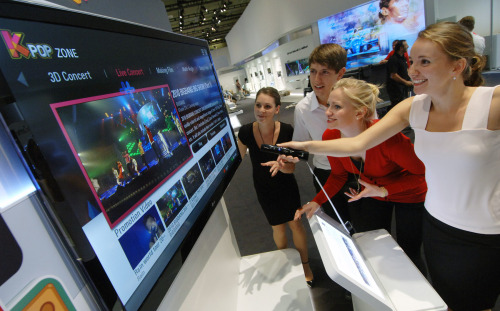Easier, cheaper 3-D glasses to attract greater number of consumers
BERLIN ― The launch of 3-D televisions is nothing new to the industry. In fact, the products dominated last year’s global electronics trade show IFA.
The industry, however, is eying the future development of passive 3-D technology, also known as passive 3-D film-type patterned retarder (FPR) technology, at IFA 2011.
“There is strong support for the development of passive 3-D because the glasses are easier and cheaper, so there is a much lower investment by the consumer,” said Jurden Boyny, global director of consumer electronics at market intelligence firm GfK Europe.
“What we are seeing is that 3-D at home is a communal thing with people tending to watch the film or the show in a family group or inviting friends round, and then you need four, five or six pairs of glasses and at that point passive 3-D becomes a very attractive proposition.”
Arguments over the superiority of active and passive 3-D technology have been ongoing in Korea, with world’s No. 1 TV maker Samsung Electronics applying the active shutter glass technology and its rival LG Electronics supporting the passive FPR technology.
BERLIN ― The launch of 3-D televisions is nothing new to the industry. In fact, the products dominated last year’s global electronics trade show IFA.
The industry, however, is eying the future development of passive 3-D technology, also known as passive 3-D film-type patterned retarder (FPR) technology, at IFA 2011.
“There is strong support for the development of passive 3-D because the glasses are easier and cheaper, so there is a much lower investment by the consumer,” said Jurden Boyny, global director of consumer electronics at market intelligence firm GfK Europe.
“What we are seeing is that 3-D at home is a communal thing with people tending to watch the film or the show in a family group or inviting friends round, and then you need four, five or six pairs of glasses and at that point passive 3-D becomes a very attractive proposition.”
Arguments over the superiority of active and passive 3-D technology have been ongoing in Korea, with world’s No. 1 TV maker Samsung Electronics applying the active shutter glass technology and its rival LG Electronics supporting the passive FPR technology.

The debate is to further intensify as the sales of worldwide 3-D TV are expected to grow to 50 million sets in 2012, up from the projection of 20 million sets this year.
DisplaySearch, another well-known market research company, also said 3-D models will become 45 percent of total TV shipments in Western Europe and 30 percent of Eastern Europe in 2015.
“The technology of 3-D displays is evolving fast and we can already see a shift from the first generation (active shutter) to passive shutter glasses,” said the firm in a release dubbed “3D: From Novelty to Maturity.”
It elaborated that the passive 3-D displays reduced flicker and increased image brightness, as well as enabling frame designs which do not have to enclose electronics and LCD elements in the lenses.
Kwon Hee-won, executive vice president of the home entertainment company at LG Electronics, in fact, said TV makers like Toshiba and Philips have also adopted the passive FPR technology.
Industry watchers, however, noted that there is room for improvements to the current passive 3-D technology.
“In due course, we expect further developments of passive glasses technology, for example, to bring full resolution to each eye,” said DisplaySearch.
Industry watchers also noted that glasses-free 3-D TV is the direction to take in future, but that the transition will require some time.
“It is clear that a lot of people want to know when they will be able to buy a set that doesn’t need glasses for the 3-D effect. We have started to see the emergence of these sets since the beginning of the year and the technology is promising, but it is not yet ready for the market because the room has to be dark and the viewer cannot move very much,” said Jurgen. “What I hear from people in the industry is that it will be ready in 2013.”
By Cho Ji-hyun, Korea Herald correspondent
(sharon@heraldcorp.com)







![[News Focus] Lee tells Yoon that he has governed without political dialogue](http://res.heraldm.com/phpwas/restmb_idxmake.php?idx=644&simg=/content/image/2024/04/29/20240429050696_0.jpg&u=20240429210658)










